



We Need Your Support!
We want to remind you that Athens by Locals is reader-supported. By booking tours, hotels, tickets, and other travel services through the links on our website, you can help us continue providing valuable content and information. Note that we receive a small commission only if you make a booking using our links at the time of your visit. So, if you're not quite ready to book yet, you can save this post and the links and return to make your booking when the time is right. We genuinely appreciate your support and are thrilled to have you in our travel community. Please don't hesitate to reach out if you have any questions or need assistance. Happy travels!
The Temple of Olympian Zeus and the Arch of Hadrian are both names that you’ve probably come across while planning your next trip to Athens. Now, you might think that the location of these sites – a few minutes away from Acropolis, Syntagma, and Zappeion Hall – might be the sole reason for their inclusion in top-notch travel guides and publications.
But you’d be surprised to find that there is much more to these significant monuments than serving as a unique backdrop for tourist photographs; and that their reputation is completely justified.
Of course, the iconic attractions of Athens like the Parthenon and the Acropolis museum will always end up on the top spots of your bucket list.
Yet, we urge you to save some time for visiting the Temple of Olympian Zeus and the Arch of Hadrian, especially if you’re interested in experiencing the rich cultural heritage and history of Athens.
All you have to do now is follow this guide and make the most of your time there.

The Temple of Olympian Zeus, more commonly known as the Columns of Olympian Zeus or simply the Olympieion among the locals, refers to the remnants of an ancient colossal temple that was dedicated to Zeus, the patriarch figure of all Olympian Gods and the ruler of Mount Olympus.
The famous temple is located in the city center of Athens, just a short walk away from the Acropolis and Syntagma Square.

The construction of the Temple of Olympian Zeus began in the 6th century BC, a time when Athens was still ruled by the notorious Athenian tyrants who commissioned its erection with the vision of it ultimately being the largest and most impressive monument in the world.
A few years later, its construction was halted due to a radical change in the city’s regime marked by the banishment of tyrant Hippias to exile.
For no less than 338 years, the temple remained incomplete, in danger of being forgotten in the sands of time.
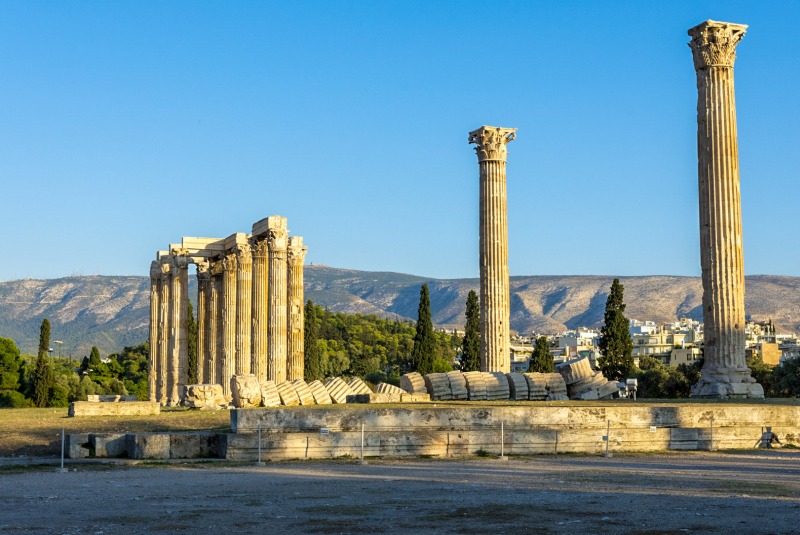
It wasn’t until 174 BC when King Antiochus IV ordered the continuation of the construction while also decreeing that the monument be built with Pentelic marble rather than limestone and instructing that the architectural style change from Doric to Corinthian.
King Antiochus met his end before seeing the manifestation of his ideas; however, once again, the vision of the Temple of Olympian Zeus was coming close to being devoured by Lethe.
Just as the dreams of grandeur were beginning to fade, and approximately six centuries since the last stone was set into place, the Roman emperor Hadrian commanded the resumption of the construction, and this time, the Temple of Olympian Zeus came to completion.
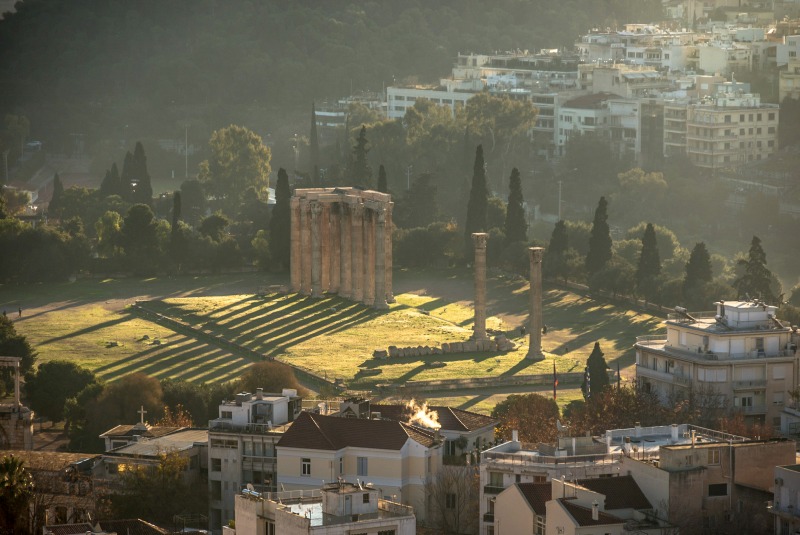
The result was no less than stunning, complete with 104 columns, a large collection of religious statues, and the famous gargantuan Chryselephantine statue of Zeus.
During the Roman period of Athens, the Temple of Olympian Zeus was widely regarded as one of the most impressive architectural feats of the time, finally getting the glory it was destined to from centuries ago.
Unfortunately, a long series of wars, invasions, and environmental catastrophes -with the most notable among them the barbarian invasion of 267 AD- left the temple in ruins.
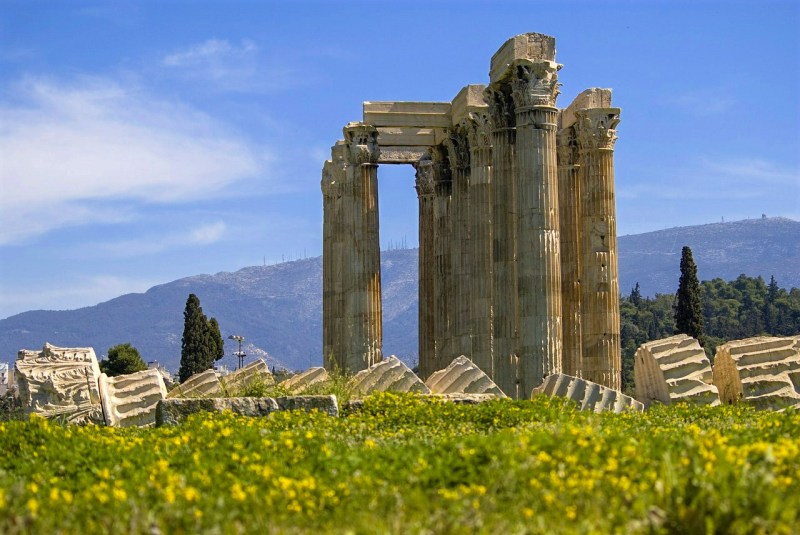
Today, only sixteen of the original columns survive, though they are more than enough for it to be considered one of the most significant archaeological monuments in Greece and one of the top attractions of Athens.
The Temple of Olympian Zeus remains open daily, both in summer and winter, allowing visitors to witness its grandeur any day they wish to.
Its opening times do differ from season to season, however.
The temple is open from 8 am to 3.30 pm from November through March. The temple is open from 8 am to 7 pm from April through October.
Entrance to the Temple of Olympian Zeus is free for EU citizens up to 25 years old.
For non-EU citizens, the entrance fee is free for children up to 5 years old.
The rest of the visitors must pay a fee to enter the temple’s premises. The ticket costs €6, but there is also the option for a reduced fee of €3 for students.
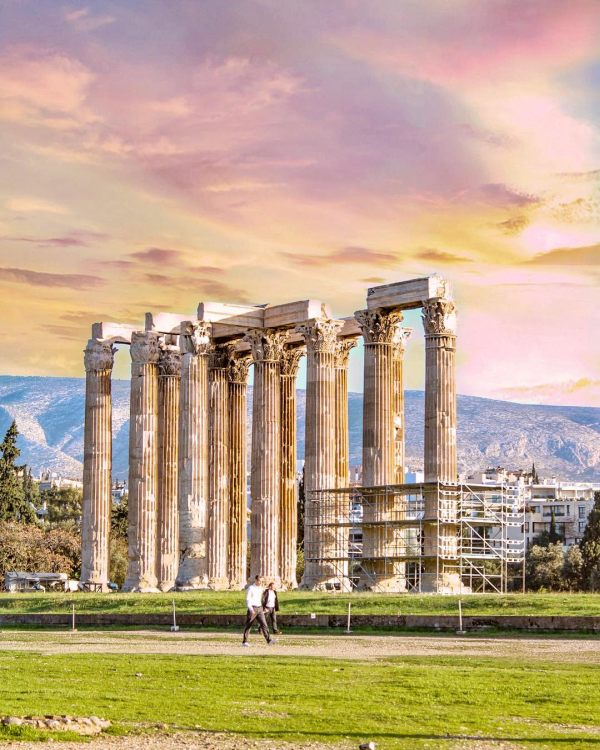
Visit all the must-see attractions in Athens with a skip-the-line ticket!
The Arch of Hadrian is an imposing triumphal arch constructed to celebrate Roman Emperor Hadrian’s accession and commemorate his benevolence and generosity to the city of Athens.
It remains unclear who commissioned and was responsible for designing and building the monument, yet its value as one of Athens’s most prominent archeological landmarks is undeniable.
The Arch of Hadrian has a symbolic location; it was built right between the ancient city of Athens and where Hadrian’s new city was beginning to take form.
Today, Hadrian’s Arch still stands halfway between the Acropolis and the Temple of Olympian Zeus enjoying its fame as one of the top 10 attractions in Athens.
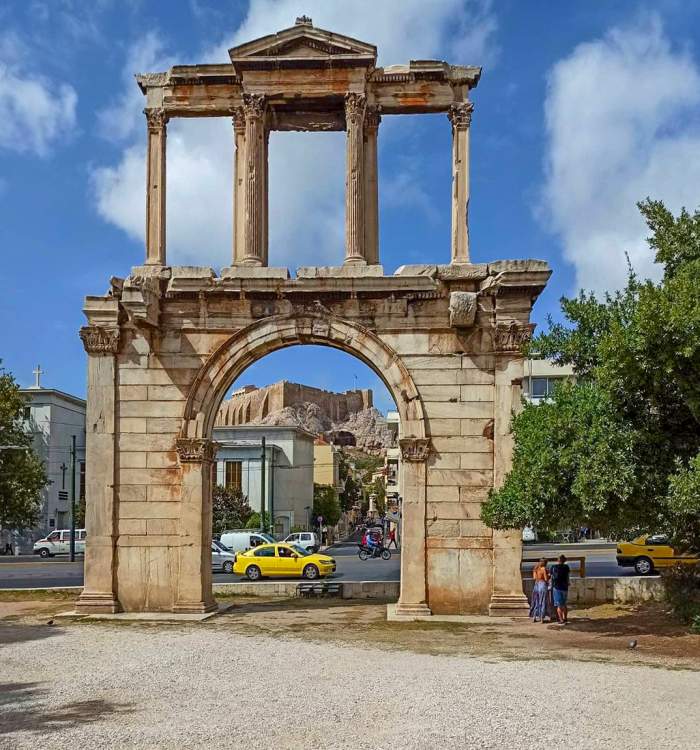
The construction of Hadrian’s Arch is estimated to have begun in 131 AD.
The impressive monument features large masses of Pentelic marble sculpted symmetrical to form the arch standing on top of columns with Corinthian-rhythm pilasters.
The whole design is not much different than the typical Roman arches that were common at the time.
And a fun fact: there are two different inscriptions carved in stone on each side of the Arch of Hadrian. The one on the side that faces Acropolis Hill reads: “This is Athens, the ancient city of Theseus”, while the one on the side that faces what was then the new city reads: “This is the city of Hadrian and not of Theseus”.
A long time after its construction, in the 18th century, Hadrian’s Arch was used as one of the seven main gates that formed a defensive wall around the city built by Turks to protect the city from raiders and pillagers.
Today, the Arch of Hadrian still stands tall amidst the hustle and bustle of modern-day Athens, inviting visitors to immerse themselves in the city’s fascinating history.
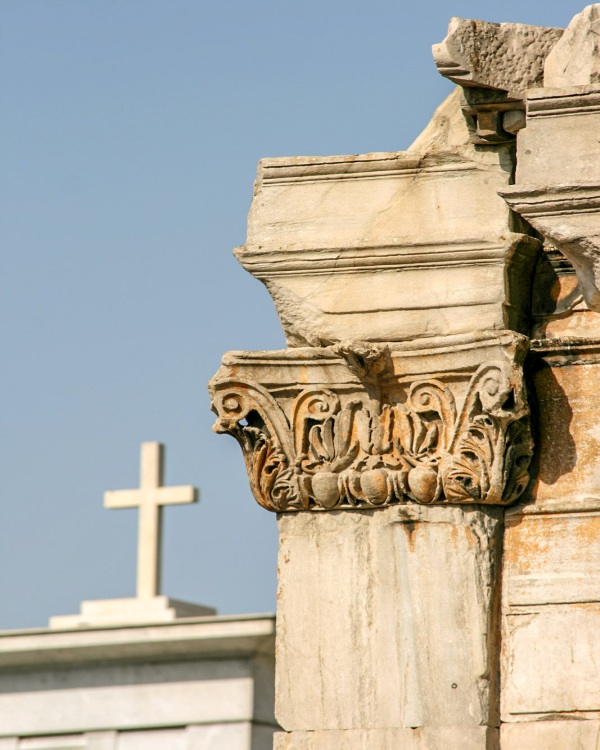
Both the Temple of Olympian Zeus and Hadrian’s Arch boasts a very central location in the heart of Athens and are situated very close to each other.
The best way to get there is by taking the metro and getting off at Acropolis station (red line), Syntagma station (red and blue lines), or Syggroy-Fix station (red line).
However, if you’re already downtown, you can also easily walk to the monuments from the Plaka neighborhood, Syntagma, Thission, Petralona, and the iconic Monastiraki.
There are plenty of hotels near the Temple of Olympian Zeus and the Arch of Hadrian to choose from.
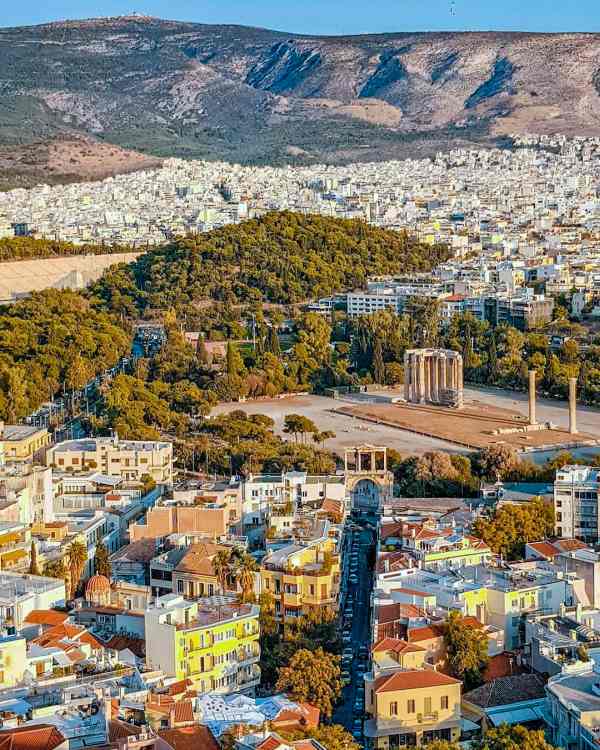
And to be completely candid, even if you weren’t looking for a hotel close to these monuments, there’s a good chance you would book your stay in one anyway, considering their location is in the heart of downtown Athens.
Accommodation options in the nearby areas of Plaka, Syntagma, Koukaki, and Thission are virtually endless, but we’ll try our best to help you pick the hotel that is more suitable for your needs.
If you’re looking for a truly luxurious hotel experience near the Temple of Olympian Zeus, look no further than The Athens Gate Hotel which features lush accommodation with great views as well as a high-end rooftop restaurant.
Check The Athens Gate Hotel on booking.com. It is rated 8.9 out of 10 by Booking.com guests!
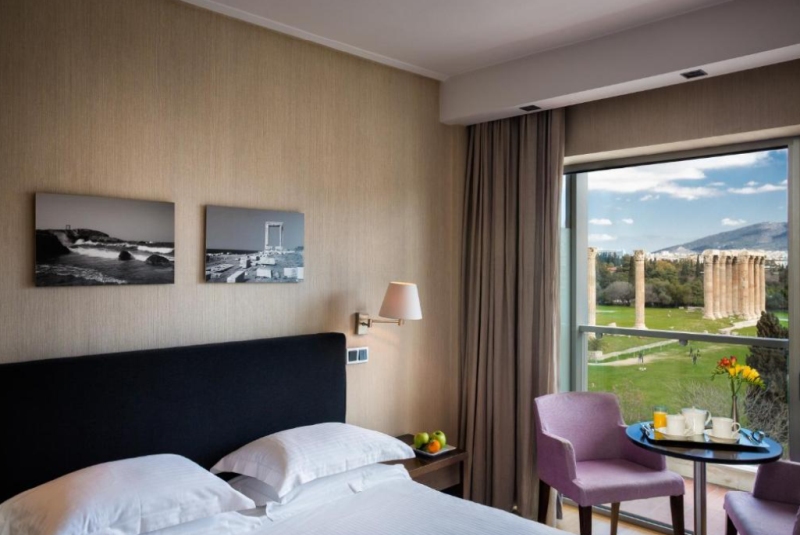

Another example of a sought-after luxury hotel situated close to the famous monuments is Electra Palace Athens, a five-star hotel that offers impeccable personalized services and features an inviting rooftop outdoor pool with birdseye views of Athens.
View rates and availability calendar for Electra Palace Athens on booking.com.
On the other hand, if you want to skip the traditional-style accommodation options in favor of a tailor-made boutique hotel experience for your stay in Athens, (read here in which area to stay in Athens and why), your options will be all but limited.
Located in the famous area of Koukaki, Coco-mat Athens BC should be among your first choices if you’re looking for contemporary design and a fresh atmosphere in the heart of Athens.
Check photos and reviews on booking.com. The Coco-mat Athens BC hotel is rated 9.4 out of 10 by Booking.com guests!

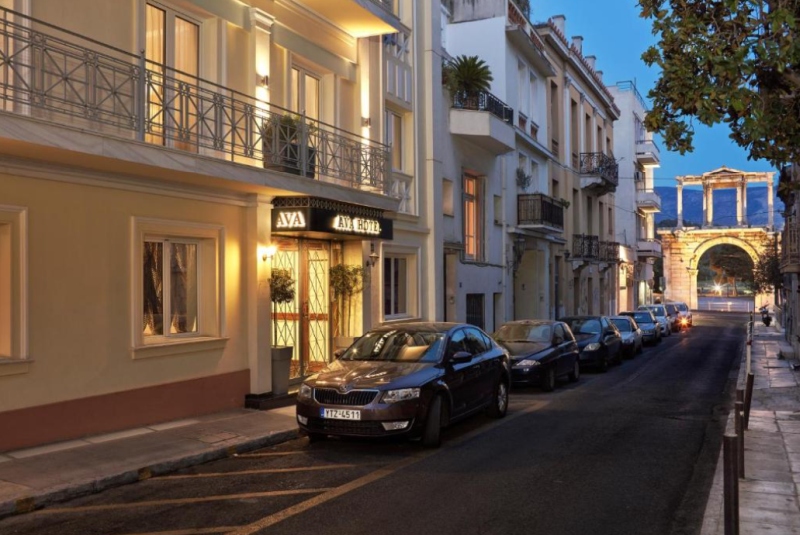
Alternatively, consider booking your stay with one of Plaka’s finest hotels, AVA Hotel and Suites, for a classy suite or deluxe room with amazing balcony views of the Acropolis.
Finally, staying in downtown Athens can surely prove to be pricey but that doesn’t mean you will have a hard time finding more budget-friendly hotels near the Temple of Olympian Zeus and the Arch of Hadrian.
Just have a look at the three-star Omiros Hotel which features cozy accommodation with fully refurbished rooms. One of the best value-for-money accommodation options for your stay in Athens.
Not convinced yet? Adam’s Hotel will prove our point by offering comfortable accommodation at great prices. Among all the budget hotels in Athens, Adams Hotel is very popular among tourists! And the best part? It’s right next to the metro station and only a short walk from the city center.
Marveling at the ancient wonders of Athens and discovering its famous monuments is one thing, but there will come a time when you will need to take a short break and get a taste of authentic Greek cuisine.
When this time comes, make sure to check out these recommendations for the best restaurants near the Temple of Olympian Zeus and the Arch of Hadrian.
The Athens Gate Roof Top Restaurant is excellent for those looking for a premium gastronomic experience. Occupying the top floor of the Athens Gate Hotel, this restaurant combines an eclectic mix of Greek and Mediterranean cuisine with impeccable views of the Acropolis.
Veganaki is located just a breath away from the Temple of Olympian Zeus and the Arch of Hadrian. Though it might seem like a sophisticated street food joint at first, there’s no doubt their homemade healthy vegan snacks and meals will convince you otherwise.
Located just a breath away from the Acropolis metro station, Belpaese is a charming small restaurant serving traditional Italian cuisine paired with a large collection of wines. It is an ideal haven for a quick pit stop between sightseeing.
Though located just a bit further away from the rest of our suggestions on this list, we’re sure that the contemporary Greek cuisine and the panoramic terrace views of this Michelin Guide-recommended restaurant will make the walk worthwhile.
If that’s not enough and you need more options about where to eat in Athens, we’ve got you covered. Check out some of the best restaurants in Athens at the link below.
Even though both Hadrian’s Arch and the Temple of Olympian Zeus are among the top attractions in Athens, the significance of the two monuments for Greek history and culture is often overlooked.
In this section, we’ll try to answer frequently asked questions regarding the two monuments and give you some useful tips for your visit.
The Temple of Olympian Zeus was originally used as a place of worship for the leader of the Olympian Gods and ruler of Mount Olympus, none other than Zeus.
The Temple of Olympian Zeus was constructed as part of a building program that Roman Emperor Hadrian designed for Athens around the year 125 AD. The temple was built with Pentelic marble and occupied a prominent position within the confines of the ancient city of Athens.
Entrance to the Temple of Olympian Zeus is free of charge only for children up to 5 years old and EU citizens up to 25 years old. The rest of the visitors need to purchase a ticket. The tickets cost €6 (six euros). There are also reduced fee tickets for students that cost €3 (three euros).
The Temple of Olympian Zeus is one of the oldest buildings you can see in Athens. Its construction started in 131 Ad, meaning that the impressive building is no less than 1890 years old.
The construction of the Temple of Olympian Zeus was a process spanned several centuries. Thus many architects contributed to its final form, However, some of those that are commonly credited for having worked on the impressive monument include Antistates, Antimachides, Callaeschrus, and Porinus among many others.
The temple of Olympian Zeus stands at approximately 21 meters high.
In its complete form, the Temple of Olympian Zeus had 104 columns made of marble. Each was around 17 meters high and had a diameter of 2 meters.
It is estimated that Hadrian’s was built around 131 AD, not long before the Roman Emperor Hadrian arrived in Athens for a visit.
The Arch of Hadrian is located in Athens, Greece. Its was built to celebrate the arrival of Roman Emperor Hadrian to the city and commemorate his contribution to making Athens one of the greatest cities during his time.
To sum it all up, we’re certain that sights like the Parthenon and Acropolis Museum will always be at the top of your bucket list.
We’re certain, however, that after reading this detailed guide and getting more insight into the significance of the Temple of Olympian Zeus and the Arch of Hadrian have for the cultural heritage of Athens, you’ll be able to see them in a new light and enjoy them for what they truly are; two of the most impressive and symbolic landmarks of the marvelous city of Athens.
A Quick Reminder:
Remember that Athens By Locals is here to guide you with planning the perfect trip to Athens and help you every step along the way. If you didn’t found what you’re looking for, or need any recommendations about your trip to Athens, feel free to contact us and we will do our best to help you. Please be as more detailed as possible regarding your subject so as to help you better.
If you like what you read please scroll down at the end of this page and subscribe to Athens By Locals so next time to receive more articles like this straight forward to your email. Join us on Facebook for comments, photos, and other fun stuff. If you enjoy this article please share it with your friends on Facebook.
Copyright © 2024 Athens By Locals © All rights reserved. No part of this site may be reproduced without our written permission.
Images owned by Athens By Locals. Image Banks or Companies promoted.